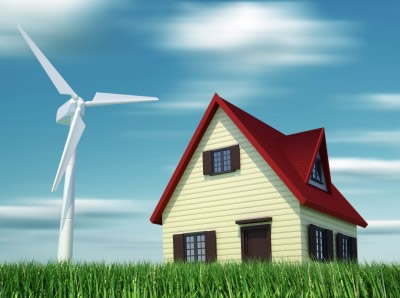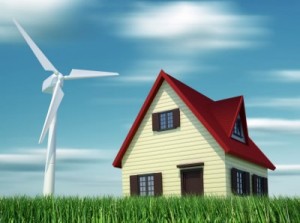 Wind Farms and Energy Generation
Wind Farms and Energy Generation
Low Energy Bills = Happy Homeowners
Most of us think of wind turbines in terms of wind farms that cover hundreds of square miles and consist of hundreds of individual wind turbines. The largest wind farms have the capacity to generate hundreds of Megawatts of electricity and the size of these wind farms range from a few wind turbines to several hundred. But wind turbines are moving toward a more affordable model so that individual homeowners can now take advantage of this alternative energy source.
Large wind farms
Texas holds the distinction of being home to the two largest wind farms in the word (as of November 2010). And the capital of the great state of Texas is Austin – the greenest city in the entire world – which is home to Green Host It, a green web hosting provider that offers carbon neutral web hosting powered by wind energy.
Home wind energy
In our previous blog entry, we wrote about home solar energy systems. So, welcome to another of our blog entries in our series of “how-to” articles on topics related to lowering energy bills. We’ll keep it simple, eliminate the techno-babble and provide, not only the tools, but the know-how to achieve the goal of lower energy bills. Your success is our success.
Take control of your electricity bills
Take control of your own electricity production with home wind turbines. Pretty simple, at least in theory. By installing a home wind energy system, homeowners are able to lower energy bills. But how expensive are these home wind turbine systems and how difficult are they to install on your home?
Sticker shock
Most alternative energy sources are modeled at a payout rate of around seven years. That means that whether you choose wind power or solar power; the system is designed to produce about enough energy to pay for itself in seven years. The sticker shock comes in because many people have not calculated just how much energy they use. If we as homeowners look at the monthly payments that we are making to the energy company, the monumental consumption of power that takes place in every home is extreme and by looking at our energy cost as a whole, rather than monthly payments — the cost of an alternative energy system does not seem as extreme. When homeowners look at an alterative energy system in this light, it does not seem as expensive as traditional energy from the electrical grid.
Tax credits
Under the Energy Improvement and Extension Act along with The American Recovery and Reinvestment Act, homeowners are allowed to take 30% of the cost of any wind or solar home power system as a tax credit. Prior to 2009, this credit had an upper limit. Currently, however, the credit has no upper limit. This means that if you install a $30,000 wind power system you are eligible for a $10,000 tax credit. That is above and beyond the savings the system itself will yield in terms of power generation, and it cuts significantly into the initial investment required to start utilizing renewable energy. The key to long-term energy savings is choosing the correct home-energy investment and staying in your home long enough to benefit from the investment.
Where to start
Where to start? Well, if you don’t know anything about wind energy, researching the web is the place to start. How does it work? How do you connect to it? How do you install and pay for it, for instance? A Salt Lake City company, Homewind.net, has been providing information and services to the public since 1998. They have extensive knowledge of the alternative energy industry and offer home wind turbines to help lower the cost of home energy. Their web site provides information for both residential and commercial applications and it offers a long list of home wind energy products.
Wind turbine – a short history
The mechanical basis for the turbine has been in existence for centuries, since the invention of the mill. Early men sought to find more effective ways to run their mills which led to earlier versions of the wind turbine that we know of today. The modern home wind turbine replaces the mill apparatus with a simple generator which produces electricity that can be used to power a house, boat or provide electricity to a remote location.
Installation locations
Rooftop turbines are meant to be portable, and easy to install on top of your house, garage, or atop a commercial building such as a small business. From there, they provide energy for the residents inside. Sometimes these can power the entire household, but more likely they are used in tandem with the traditional power grid to reduce use and costs.
In remote locations, the energy gathered from rooftop wind turbines can be stored in a battery for later use. Typically, however, on days the wind blows especially hard, this excess energy that is not immediately needed can be sold back to the utility company. In this way, especially if you limit your energy use, rooftop wind turbines can gradually become profitable.
Energy savings
Over the long run, home wind systems can lead to considerable energy savings which can justify investing in a residential wind turbine system, even if such a purchase can be costly up-front. One turbine should be enough to power a house if it is located in a very windy area.
Is it practical to use this energy source to power a home?
The answer is definitely a big yes. However it is important to make sure you have the right system. Which system you need will depend on where you live and how much energy you need. For instance, if you live in a very windy area you might be able to produce more electricity than you need and even sell some back into the grid, which is a nice alternative to paying for energy.
Green homes
Home wind energy systems can benefit your home and family because the quality of your life can be improved with lower energy bills, providing a better life today and in the future. Highly efficient wind turbines are no longer available for large corporations only and individual homeowners can take advantage of this renewable energy source.
If you choose an alternative energy source for your home, good for you. Sit back and relax with the thought that you are not only reducing your carbon footprint, but you are also saving on your monthly electricity bill. Then, wait for the energy savings to start building up in terms of money in your bank account. It can – if you do it right.

 Follow
Follow